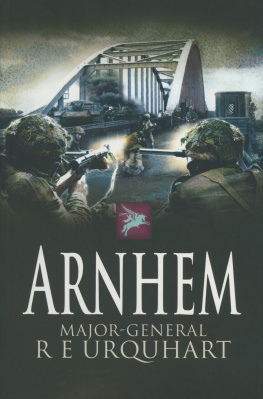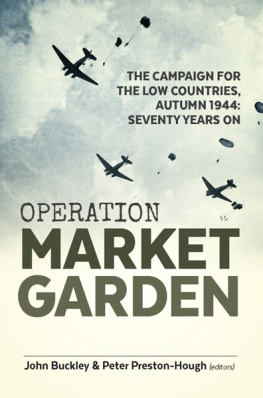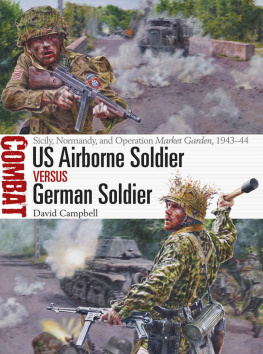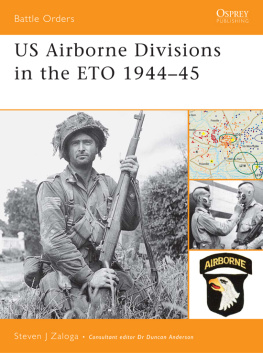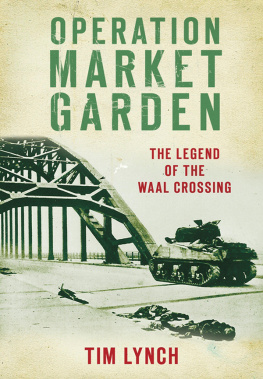Operation Market Garden in 24.389 Words
The Concise History of The Biggest Gamble of World War Two
Tom Leferink
Copyright 2019 by Tom Leferink
All rights reserved. This book or any portion thereof
may not be reproduced or used in any manner whatsoever
without the express written permission of the publisher
except for the use of brief quotations in a book review.
Contents
Prologue
Chaplain Bernard Egan had been with the 2 nd Parachute Battalion at Arnhem Bridge since the evening of the 17 th of September 1944.
During the first few days of his arrival, fighting had been severe, and Egan had witnessed immense acts of gallantry and self-sacrifice. He was at the Regimental Aid Post when one of the medics show him to a young paratrooper who lay dying and probably had no more than fifteen minutes to live. While Egan tried to impart some comfort to him, the soldier suddenly said, Please Father, ask some of the medics to lay me down in a firing position somewhere. I can still hold a rifle. I can still fight.
That wont be possible, Im afraid,Egan replied soothingly, The medics are too busy taking care of the others. A few moments later, the young paratrooper lay quietly staring ahead. I just hope the other lads wont think I let them down, he uttered woefully. Chaplain Egan stayed with the soldier until he passed away. He was twenty years old.
1. The Dawn Of Liberation
On the morning of June 6, 1944; with World War II well into its 5 th year, Allied troops launched what is to this day, the largest amphibious invasion ever carried out - Operation Overlord.
More than 5000 ships lay off the coast of Normandy, France, ready to bombard the German positions and send ashore some 130,000 soldiers who had been itching to go for the past 48 hours. The fury of the Free World was about to be unleashed onto Hitler's so-called Atlantikwall; a series of fortifications stretching along the coast of occupied Western Europe.
The night before, three airborne divisions, two American and one British, had been dropped into Normandy via transport planes and gliders. These well-trained units were tasked with securing vital roads leading inland from the beaches; capturing strategically important towns and crossroads; wreaking havoc and, creating as much chaos as was humanly possible.
The American 101 st and 82 nd Airborne Divisions were dropped on the west flank of the invasion beaches to protect troops coming ashore from potential German counterattacks. Due to heavy German anti-aircraft fire, the pilots transporting these divisions split formation and often gave the green light to parachutists to jump at the wrong moment. As a result, most American paratroopers missed their designated drop zones and were completely scattered across the territory.
This however, did not dampen their spirits and soldiers simply banded together in groups of paratroopers from different Battalions and Regiments, focused on still achieving the objectives they had been given.
The fact that the 101 st and 82 nd Airborne Divisions were so scattered, ultimately and positively had the unintended effect of confusing the Germans even more.
A few hours prior to the Americans parachuting into Normandy, their British colleagues had landed to the east of the invasion beaches, near the city of Caen. One company of British paratroopers had captured the all-important Pegasus Bridge over the Orne Canal. Using gliders, they had managed to land only a hundred meters or so from the bridge. Their insertion had been so stealthy that the Germans only realized their presence when they witnessed them charging at the Bridge, which, by that time it was too late. This company had landed at 00:16 hours on June 6, making them the first Allied unit to set foot on French soil.
At daybreak, the guns of Allied warships opened fire, waking the Germans in their pillboxes with a massive bombardment. In the skies above, 8000 planes incessantly hammered the German defenders below, whilst sim soldiers aboard the ships simultaneously scaled the rope ladders into their landing crafts, ready to storm ashore.
They knew that many of them wouldnt make it back.
By the end of that first day, Allied troops had secured all the landing beaches and had begun to bring in more men and material and link up with their airborne force counterparts further inland. German resistance had been weaker than expected. Only at codename, Omaha Beach did US 1 st and 29 th Infantry Divisions suffer massive casualties. At Juno Beach, Canadian troops wading ashore facing stiff German resistance. However by around midday, they had secured the beach and were moving further inland. Overall the German resistance was a lot weaker than the Allied commanders had initially feared. The Atlantikwall had not proven to be as impenetrable as Hitler had boasted.
Even though D-Day proved successful, the coming weeks would turn out to be a different and more terrifying experience for the Allies. The German commander in France, Field Marshall Erwin Rommel, had directed German reinforcements to Normandy and Allies were finding it difficult to adjust to the terrain. The countryside in Normandy was mostly made up of so called bocage , high and dense hedgerows separating small fields from each other. This terrain strongly favored the defending Germans while the Allies often found themselves struggling to breakthrough this thick vegetation.
On the eastern flank, British and Canadian forces, under the command of Field Marshall Bernard L. Montgomery, had failed to capture the city of Caen despite multiple efforts and heavy air support. Before the invasion, Montgomery had claimed his forces would be able to comfortably capture Caen on the first day. In reality, it took weeks.
Allied forces in Normandy spent the rest of June and the first half of July, struggling to gain ground. In the West, American forces under General Omar N. Bradley, fought the Germans in the bocage . In the East, Canadian and British forces under Montgomery, did battle at Caen and its surrounding area. The overall command of the Allied forces lay with the American, General Dwight D. Eisenhower and he was growing impatient. As a result, he gave Montgomery the green light to go ahead with Operation Goodwood.
This plan, drawn up by Montgomery was designed to smash through the German lines on the Eastern flank and drive towards Falaise, a town to the South of Caen.
Operation Goodwood was launched on the 18 th of July 1944 and began with a tremendous bombardment from the air. Tanks quickly advanced but were ambushed by German anti-tank guns, well hidden in the bushes and hedgerows. The British 11 th and the Guards Armoured Divisions, who were leading the offensive at the time, lost nearly 200 tanks in one day. Within days the attack was called off and Montgomerys reputation had suffered a blow.
On July 25 th , General Omar Bradley launched his offensive in Western Normandy, codenamed Operation Cobra. This attack also began with an apocalyptic aerial bombardment just to the west of the crossroad town of St. L. This time the attack was successful and American forces broke through the German lines. After weeks of fighting, the deadlock in Normandy had been broken. By this time the Allies had almost 1.4 million troops in the beachhead with more divisions in England and the Mediterranean ready to be brought in.
With the breakout, Allied forces now swarmed across France. Due to Allied forces and their collaborative air-superiority, any German resistance was quickly brushed aside. A German counter-attack ordered personally by Hitler on the 6 th of August had disastrous consequences, with Allied troops quickly managing to surround the German forces at Falaise. Some German units managed to escape, however 50,000 men became trapped in what became known as the Falaise-Pocket. It was at this point that German resistance began to crumble.


